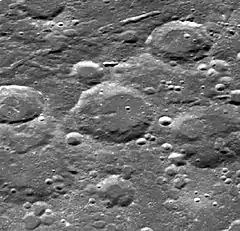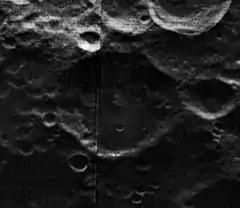 Clementine image with Dyson at center | |
| Coordinates | 61°18′N 121°12′W / 61.3°N 121.2°W |
|---|---|
| Diameter | 63.14 km |
| Colongitude | 187° at sunrise |
| Eponym | Frank W. Dyson |

Dyson is a lunar impact crater, 63 kilometers in diameter, that lies on the far side of the Moon, past the northwest limb. It is located in the northern part of the surface, to the northwest of the crater Coulomb, and east of van't Hoff.[1]
The most unusual aspect of this crater is the asymmetry of the inner wall. To the northeast the rim is low and the inner wall is quite narrow, almost non-existent. This portion of the rim overlies the interior of an unnamed depression in the surface; most likely a damaged crater. In the remaining arc between the eastern rim clockwise to the north, the inner wall is much wider. As a result, the level inner floor is offset toward the northeast. The interior has a central peak located near the midpoint of the crater, then forming a linear ridge that continues until it reaches the western inner wall. The floor is otherwise nearly featureless, except for a few tiny craterlets.
The rim and inner wall have been somewhat worn by impact erosion, but are not overlaid by any impacts of significance. The small crater Dyson X is attached to the exterior of the rim along the north-northwest side. A smaller crater is nearly attached to the southwest rim, and this also lies along the northeast rim of the large satellite crater Dyson Q, a heavily eroded formation. A cluster of tiny craters is attached to the southeast rim of Dyson.
Dyson lies at the approximate margin of the Coulomb-Sarton Basin, a 530 km wide impact crater of Pre-Nectarian age.
Satellite craters
By convention these features are identified on lunar maps by placing the letter on the side of the crater midpoint that is closest to Dyson.
| Dyson | Latitude | Longitude | Diameter | Ref |
|---|---|---|---|---|
| B | 63.6° N | 117.6° W | 49.64 km | WGPSN |
| H | 59.5° N | 113.7° W | 20.96 km | WGPSN |
| M | 58.4° N | 120.9° W | 31.5 km | WGPSN |
| Q | 59.8° N | 125.7° W | 93.24 km | WGPSN |
| X | 62.6° N | 122.5° W | 25.81 km | WGPSN |
See also
- 1241 Dysona, asteroid
References
- ↑ "Dyson (crater)". Gazetteer of Planetary Nomenclature. USGS Astrogeology Research Program.
- Andersson, L. E.; Whitaker, E. A. (1982). NASA Catalogue of Lunar Nomenclature. NASA RP-1097.
- Blue, Jennifer (July 25, 2007). "Gazetteer of Planetary Nomenclature". USGS. Retrieved 2007-08-05.
- Bussey, B.; Spudis, P. (2004). The Clementine Atlas of the Moon. New York: Cambridge University Press. ISBN 978-0-521-81528-4.
- Cocks, Elijah E.; Cocks, Josiah C. (1995). Who's Who on the Moon: A Biographical Dictionary of Lunar Nomenclature. Tudor Publishers. ISBN 978-0-936389-27-1.
- McDowell, Jonathan (July 15, 2007). "Lunar Nomenclature". Jonathan's Space Report. Retrieved 2007-10-24.
- Menzel, D. H.; Minnaert, M.; Levin, B.; Dollfus, A.; Bell, B. (1971). "Report on Lunar Nomenclature by the Working Group of Commission 17 of the IAU". Space Science Reviews. 12 (2): 136–186. Bibcode:1971SSRv...12..136M. doi:10.1007/BF00171763. S2CID 122125855.
- Moore, Patrick (2001). On the Moon. Sterling Publishing Co. ISBN 978-0-304-35469-6.
- Price, Fred W. (1988). The Moon Observer's Handbook. Cambridge University Press. ISBN 978-0-521-33500-3.
- Rükl, Antonín (1990). Atlas of the Moon. Kalmbach Books. ISBN 978-0-913135-17-4.
- Webb, Rev. T. W. (1962). Celestial Objects for Common Telescopes (6th revised ed.). Dover. ISBN 978-0-486-20917-3.
- Whitaker, Ewen A. (1999). Mapping and Naming the Moon. Cambridge University Press. ISBN 978-0-521-62248-6.
- Wlasuk, Peter T. (2000). Observing the Moon. Springer. ISBN 978-1-85233-193-1.
